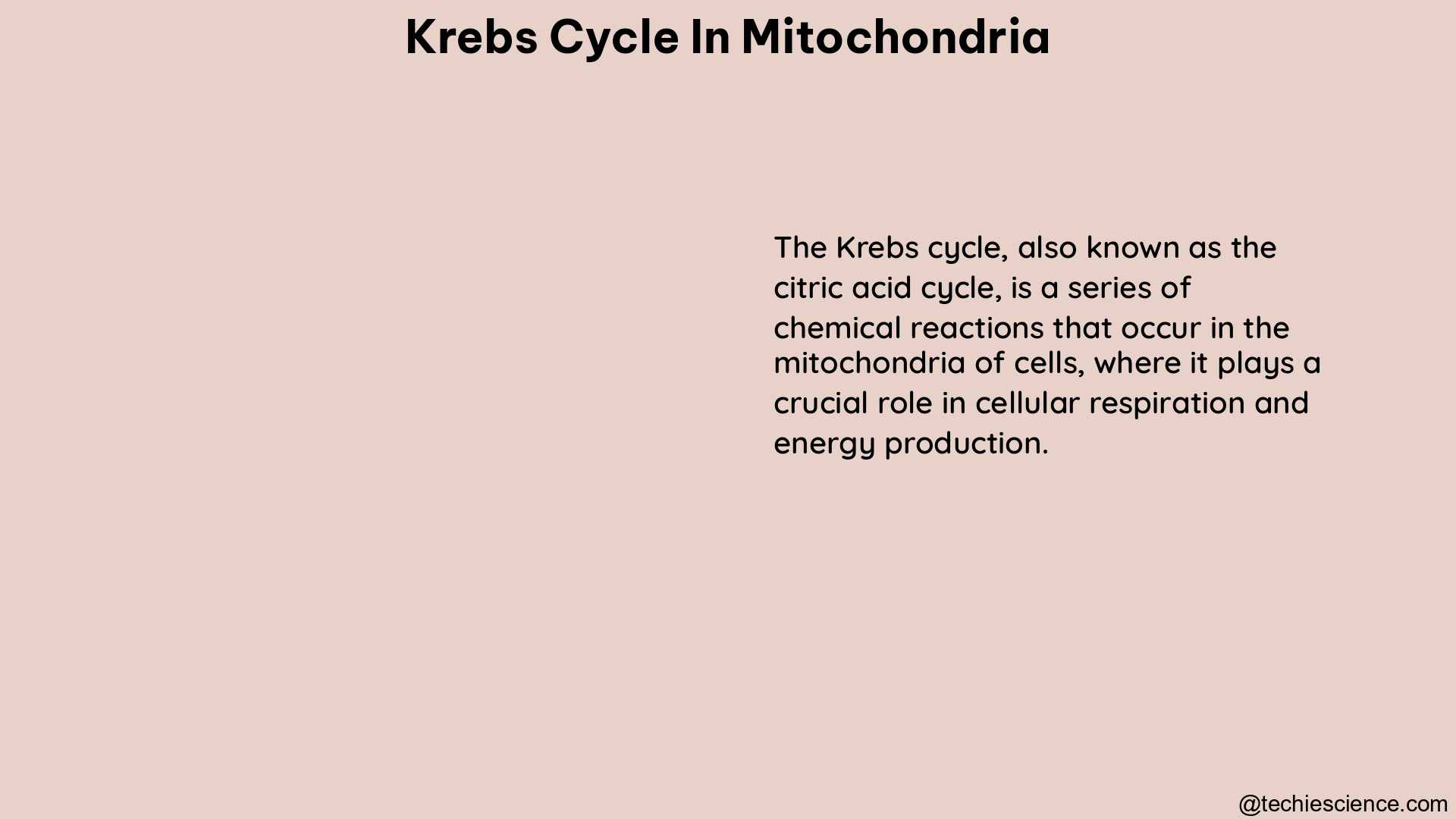The Krebs cycle, also known as the citric acid cycle, is a crucial metabolic pathway that takes place within the mitochondria of eukaryotic cells. This cyclic series of reactions is responsible for the generation of a significant portion of the energy required by the cell, in the form of ATP, NADH, and FADH2. Understanding the intricate details of the Krebs cycle is essential for comprehending the overall process of cellular respiration and energy production.
The Initiation of the Krebs Cycle
The Krebs cycle begins with the conversion of acetyl-CoA, a two-carbon molecule derived from the breakdown of pyruvate, into citrate. This reaction is catalyzed by the enzyme citrate synthase, which combines acetyl-CoA with oxaloacetate to form the six-carbon compound citrate.
| Step | Reaction | Enzyme |
|---|---|---|
| 1 | Acetyl-CoA + Oxaloacetate → Citrate | Citrate Synthase |
The citrate molecule then undergoes a series of transformations, each catalyzed by a specific enzyme, to ultimately regenerate the starting compound, oxaloacetate, and complete the cycle.
The Cyclic Reactions of the Krebs Cycle

- Aconitase: Citrate is converted into isocitrate through the removal of a water molecule.
- Isocitrate Dehydrogenase: Isocitrate is oxidized and decarboxylated to form α-ketoglutarate, generating one molecule of NADH in the process.
- α-Ketoglutarate Dehydrogenase: α-Ketoglutarate is further oxidized and decarboxylated to form succinyl-CoA, generating another molecule of NADH.
- Succinyl-CoA Synthetase: Succinyl-CoA is converted into succinate, with the concomitant production of one molecule of GTP (or ATP).
- Succinate Dehydrogenase: Succinate is oxidized to fumarate, generating one molecule of FADH2.
- Fumarase: Fumarate is hydrated to form malate.
- Malate Dehydrogenase: Malate is oxidized to oxaloacetate, generating one molecule of NADH.
The completion of the cycle results in the regeneration of oxaloacetate, which can then be used as the starting material for the next round of the Krebs cycle.
Energy Production in the Krebs Cycle
The Krebs cycle is a highly efficient process, generating a significant amount of energy in the form of ATP, NADH, and FADH2. Studies have shown that for each glucose molecule that is completely oxidized, the Krebs cycle produces:
- 2 ATP molecules (via substrate-level phosphorylation)
- 6 NADH molecules
- 2 FADH2 molecules
The NADH and FADH2 molecules generated during the Krebs cycle are then used as electron donors in the electron transport chain, a process that ultimately leads to the production of a large number of ATP molecules through oxidative phosphorylation.
Regulation of the Krebs Cycle
The Krebs cycle is tightly regulated to ensure that it operates efficiently and in response to the cell’s energy demands. Several key regulatory mechanisms have been identified:
- Allosteric Regulation: Enzymes within the Krebs cycle, such as citrate synthase and isocitrate dehydrogenase, can be allosterically activated or inhibited by various metabolites, allowing the cycle to respond to the cell’s energy status.
- Covalent Modification: Some Krebs cycle enzymes can be post-translationally modified, such as the phosphorylation of isocitrate dehydrogenase, which can alter their activity.
- Transcriptional Regulation: The expression of genes encoding Krebs cycle enzymes can be regulated by transcription factors, allowing the cell to adjust the cycle’s activity in response to long-term changes in energy requirements.
Importance of the Krebs Cycle in Cellular Respiration
The Krebs cycle is a central component of cellular respiration, as it is responsible for the complete oxidation of acetyl-CoA derived from the breakdown of carbohydrates, fats, and proteins. The energy-rich molecules generated during the Krebs cycle, such as NADH and FADH2, are then used in the electron transport chain to drive the production of large amounts of ATP through oxidative phosphorylation.
Furthermore, the Krebs cycle is closely linked to other metabolic pathways, such as gluconeogenesis, amino acid synthesis, and lipid metabolism, highlighting its importance in the overall regulation of cellular metabolism.
Conclusion
The Krebs cycle is a remarkable and highly efficient metabolic pathway that takes place within the mitochondria of eukaryotic cells. By generating ATP, NADH, and FADH2, the Krebs cycle plays a crucial role in the overall process of cellular respiration and energy production. Understanding the intricate details of this cycle, including its regulation and its connections to other metabolic pathways, is essential for a comprehensive understanding of cellular metabolism and energy homeostasis.
References:
– Krebs, H. A. (1940). The citric acid cycle. Biochemical Journal, 34(5), 775-779.
– Voet, D., & Voet, J. G. (2011). Biochemistry (4th ed.). Wiley.
– Berg, J. M., Tymoczko, J. L., & Stryer, L. (2012). Biochemistry (7th ed.). W.H. Freeman.
– Garrett, R. H., & Grisham, C. M. (2013). Biochemistry (5th ed.). Cengage Learning.

Hi, I am Saif Ali. I obtained my Master’s degree in Microbiology and have one year of research experience in water microbiology from National Institute of Hydrology, Roorkee. Antibiotic resistant microorganisms and soil bacteria, particularly PGPR, are my areas of interest and expertise. Currently, I’m focused on developing antibiotic alternatives. I’m always trying to discover new things from my surroundings. My goal is to provide readers with easy-to-understand microbiology articles.
If you have a bug, treat it with caution and avoid using antibiotics to combat SUPERBUGS.
Let’s connect via LinkedIn: